![[feature] 10 Shrubs to Plant for Seasonal Color in Your Garden](https://blogger.googleusercontent.com/img/b/R29vZ2xl/AVvXsEgmS_KvVY8cKdSzQuAqhM3pYZ79OZItbmA_rQWf_f_HjoIHKcyY0636gP0-wK4VbV_Q2RSb8RXN5Wh_shl0WtUuu93cNlROMqvc6CYdJ-QaNQgbHejL9Sl-Qv1PtlmpM9sDsEGG-tD_yaUQUTUGcvdLWE7ul--yEcq_rS8KJqxZkkmqx2EEtlHDlWS3Yg/s16000/colorful-garden.jpg) |
| Ⓒ Provided by The Family Handyman |
By Susan Martin, The Family Handyman
For persistent color in your landscape every year, plant dynamic colorful shrubs that bring interest with their fabulous foliage and brilliant blooms.
Plant Once, Enjoy for Years
Annual flowers provide loads of zesty colors for your garden, but you’ll need to plant them every year to keep the look going. Why not try some showy shrubs instead? They’ll deliver color every year, and you’ll only need to plant them once!In the list that follows, you’ll see color from shrubs doesn’t always come from its flowers. Some of them don’t bloom at all. Foliage color is paramount when choosing shrubs for year-long interest in the landscape. Several choices offer fabulous foliage and brilliant blooms.
Of course, when choosing a shrub, you’ll also need to factor in things like hardiness, maintenance and watering. Do your research before you buy to be sure your selections will actually grow in the conditions you have. Shrubs are an investment that can last for decades.
Read More: Top 10 Gardening Tips You Should Know
Golden Spirea
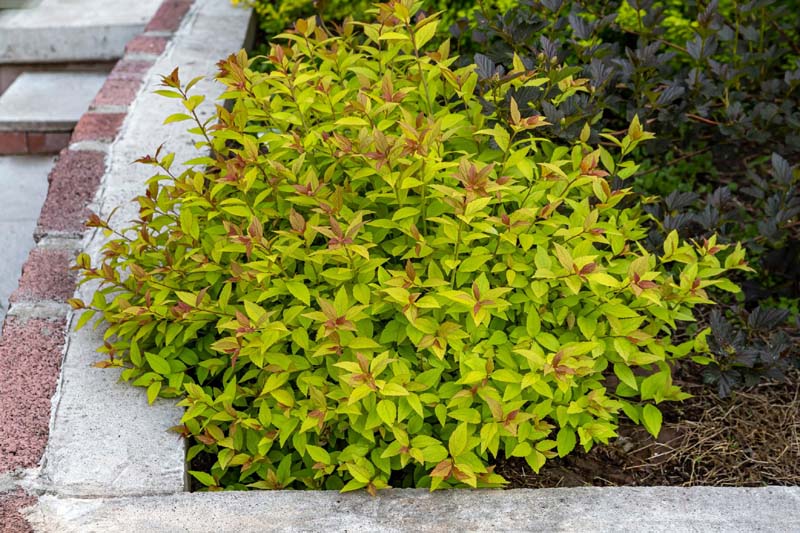 |
| Ⓒ Provided by The Family Handyman |
Here’s a shrub that’s as lively when it wakes up in spring as when its last leaves drop in autumn.
Don’t be surprised when your golden spirea sprouts tiny tangerine or flaming scarlet leaves in early spring. They’ll quickly turn bright gold with just the newest leaves at the tips of each stem retaining their warm colors by summertime.
Large clusters of bold pink, red or magenta flowers amp up the color show in late spring. Varieties like Double Play Candy Corn and Pink Sparkler are especially colorful.
Spirea is a great choice for beginner gardeners and anyone seeking low-maintenance shrubs. Plant it in a sunny-to-mostly-sunny spot near the front to middle of your garden border. It typically grows 18 to 36 inches tall and wide with a mounded shape. If you’re troubled by deer in your yard, they’ll leave these shrubs alone.
This shrub is not demanding about soil type — it even tolerates alkaline clay. Spirea generally is cold hardy to U.S. Department of Agriculture Plant Hardiness Zones 3 or 4, and heat tolerant through Zone 8. Check the label to be sure; hardiness can vary by species.
Shrub-Form Crapemyrtle
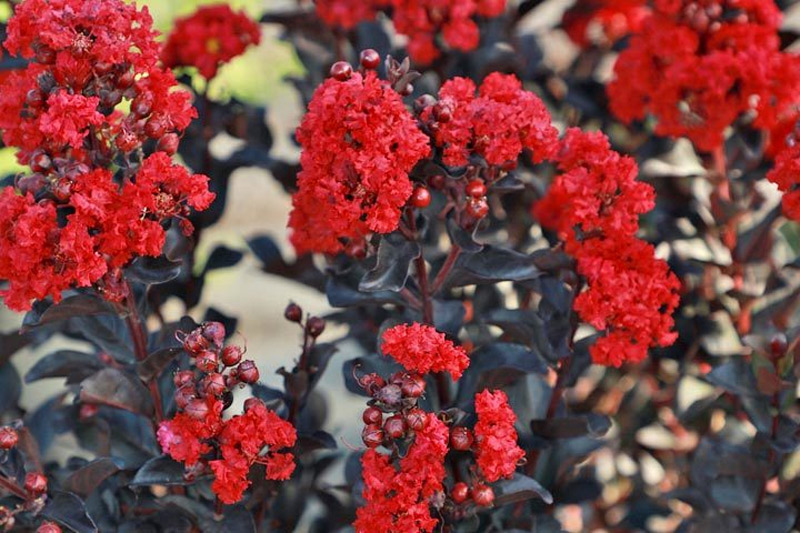 |
| Ⓒ Provided by The Family Handyman |
If you garden in the South, you’re probably familiar with tree-form crapemyrtle. It’s dubbed the “summer lilac” for its large panicles of colorful blooms that are present for much of the summer.
But smaller shrub-form crapemyrtles offer even more color for landscapes because of their striking foliage and bright blooms. Look for varieties like Black Diamond Radiant Red (pictured here) with nearly black foliage and scarlet blooms. It makes an outstanding focal point in the landscape from spring through fall.
Full sun is a must when growing shrub-form crapemyrtles. That’s what gives them their dark foliage and the energy to produce masses of brilliant blooms. When first planted, keep them watered consistently for a couple of months. After that, they’ll only need average amounts of moisture to grow well.
In USDA Zone 6 with snow cover, these shrubs will die back to the ground in winter and return from their roots in spring. In Zones 7 through 10, expect them to lose their leaves but retain their woody structure through winter, then sprout new foliage in the spring.
Oleander
 |
| Ⓒ Provided by The Family Handyman |
It’s hard to believe a shrub with such whimsical, tropical-looking blossoms could be such a durable garden plant — or one that’s deadly if ingested. But these traits come in handy for gardeners dealing with challenging conditions.
Deer and other potential browsers stay clear of oleander. Plus it tolerates heat, drought, wind, poor soil and salt spray.
Oleander fits our list because of its large, purple, pink or white, funnel-shaped flowers. They appear in clusters all over the plant beginning in late spring and last through summer. Its willowy, evergreen, dark-green leaves flutter gracefully in the breeze.
If you prefer a denser look, prune the shrub to shape it after the flowers are finished blooming in early fall. Oleander is hardy in Zones 8 through 10 and requires full sun to thrive.
Golden Arborvitae
 |
| Ⓒ Provided by The Family Handyman |
Evergreen golden arborvitaes are a perfect choice if you’re looking for continuous bright color.
You might be familiar with the common emerald green pyramidal arborvitae hedges prevalent in the North and Midwest. Try golden arborvitaes like ‘Sunkist’ and Polar Gold to form a more colorful hedge, or use them as a bright gold accent plant.
Globe-shaped cultivars like Anna’s Magic Ball work well in containers. Look for those that retain their golden color well in winter. Older varieties tend to turn copper in the coldest months, then turn back to gold in the spring.
Well-drained soil is essential to growing arborvitaes. You’ll find they suffer if planted anywhere the ground stays soggy. Despite their bright coloring, most golden arborvitaes grow well without burning in full sun, but they also tolerate part shade.
Hardiness varies by species, but they’re generally good in Zones 3 through 7.
Reblooming Hydrangea
 |
| Ⓒ Provided by The Family Handyman |
One of the most popular shrubs of all time, bigleaf hydrangeas also are some of the most brightly colored ones you can grow in your landscape. Each summer, enormous brilliant pink or blue puffball blossoms burst into bloom all over the plant.
It’s easy to spot a flowering bigleaf hydrangea from a distance; you can plant them near the back of your yard and still enjoy the color. Or place a hedge along your home’s foundation to add major curb appeal.
Look for types like Let’s Dance ¡Arriba! which blooms in waves from early summer into early fall, or Endless Summer Summer Crush which bears fabulous fuchsia flowers. Clipping a few for your fresh bouquets is no problem because more flowers will come to fill in the gaps.
Grow reblooming bigleaf hydrangeas in full sun or part shade in cooler Zones 5 and 6. In Zones 7 through 9, be sure to protect them from the afternoon sun. They need consistent water. If you can’t provide it, try a more forgiving species like panicle hydrangea.
Read More: 11 Low-Maintenance Flowers You (Practically) Can’t Kill
Landscape Roses
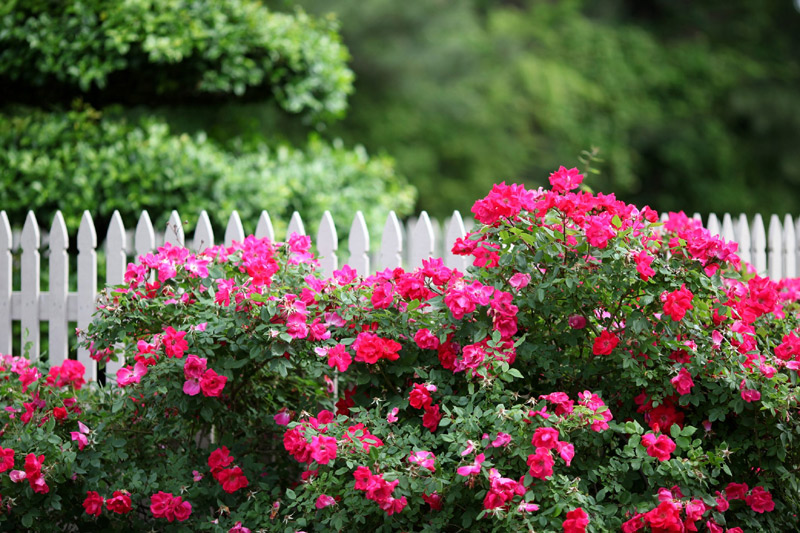 |
| Ⓒ Provided by The Family Handyman |
If you love the look of roses but need low-maintenance shrubs, go for landscape roses. Unlike their long-stemmed cousins, this type is as easy to grow as any other shrub in your landscape. It blooms nearly non-stop from early summer to frost.
Plant breeders today select landscape roses because they resist common issues like black spot and powdery mildew, so you won’t need to continually spray them to keep them healthy. Most also do not need to be deadheaded for new flowers to develop. Knock Out, Easy Elegance, Drift and Oso Easy roses are good examples of landscape roses.
They’ll need six to eight hours of full sun to keep them blooming happily and healthy in Zones 4 through 9. Average moisture and rich soil help roses thrive. Consider planting a low-growing perennial-like catmint around the feet of your roses to cool the soil.
Loropetalum
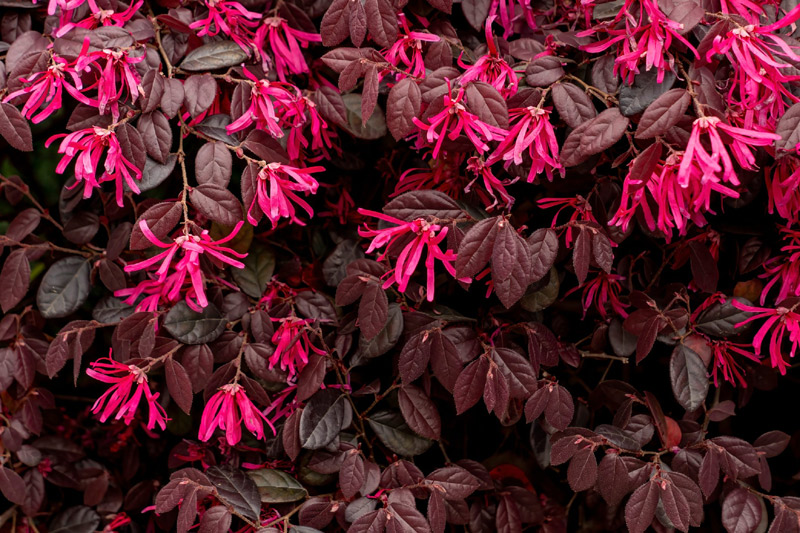 |
| Ⓒ Provided by The Family Handyman |
If most of your foundation plants are green, consider adding a purple or deep red-leaved Loropetalum for an accent near the corner of the bed. These shrubs are famed for their everlasting colorful foliage and naturally graceful, arching form that contrasts beautifully with tightly clipped hedges.
Also known as “Chinese fringe-flower”, this shrub produces masses of ribbon-like blossoms in vivid shades of magenta, pink or white in the springtime. A few flowers pop up again through the summer. You’ll find Loropetalum varieties ranging from a few feet tall to more than 15 feet, so check the label carefully if your space is limited.
Mid-sized varieties like Purple Diamond grow four to six feet tall and wide, just big enough to plant a shorter row of brilliant flowering SunPatiens impatiens in front. Together, they’ll bring months of intense, saturated color to your landscape in full sun to part shade.
Loropetalum is hardy in Zones 7 through 10. It enjoys rich, acidic, moist but well-drained soil.
Reblooming Azalea
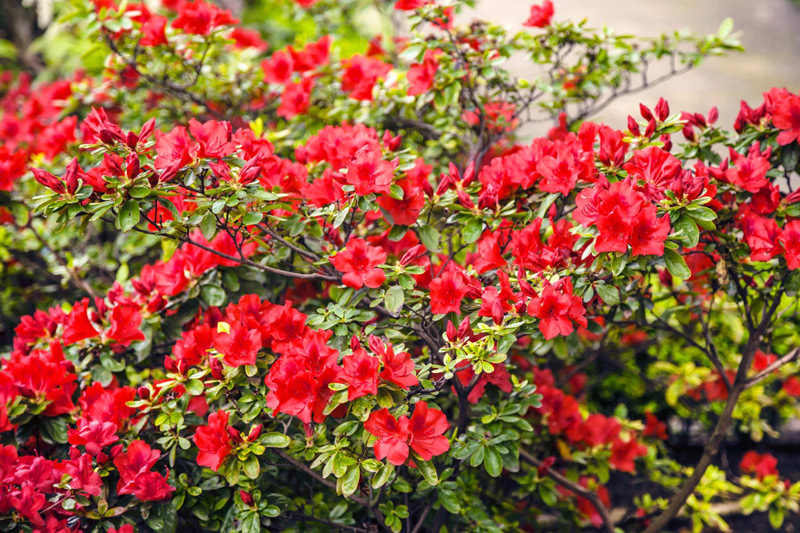 |
| Ⓒ Provided by The Family Handyman |
All azaleas bloom in the spring, but a select few like those in the Encore and Perfecto Mundo series are rebloomers. They rest in early summer, then flower again from midsummer into fall in warm shades of crimson, coral, magenta, lavender, pink and white.
When not in bloom, their deep evergreen foliage shines. Most reblooming azaleas stay less than four feet tall, so they work well as a foundation plant or in the middle-to-front of the border.
Azaleas that only bloom in the spring tend to be more cold hardy than the reblooming types, so it’s important to check the USDA zone on the label if you garden in a Northern state. Your local garden center should carry the types that are winter hardy in your climate.
Most reblooming azaleas are hardy in Zones 7 through 10, although a few can survive in Zone 6. They thrive in moist, acidic, humus-rich soils. Surprisingly, this type of azalea grows and blooms best in full sun to part sun, whereas most other azaleas require shade.
‘Kaleidoscope’ Abelia
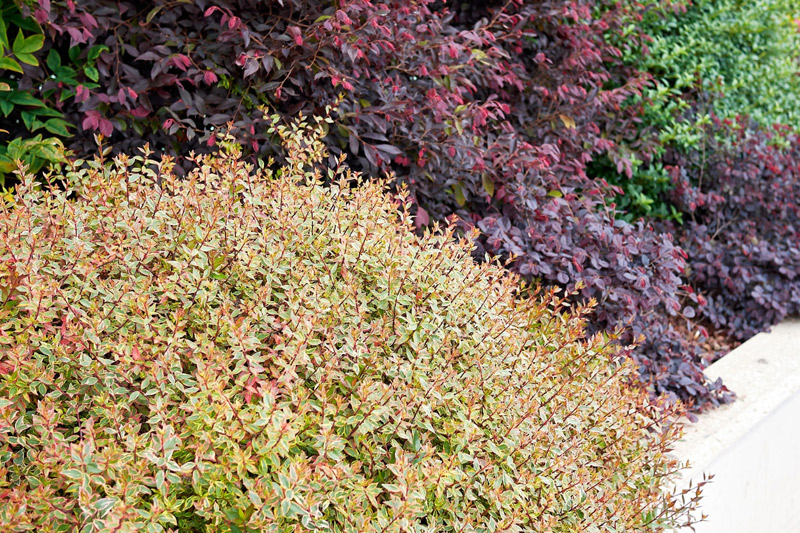 |
| Ⓒ Provided by The Family Handyman |
This variegated abelia is a popular landscape shrub in warmer climates where its semi-evergreen foliage changes colors like a kaleidoscope through the seasons.
Its leaves emerge in spring with green and yellow variegation, turn mostly gold in summer, and then finish out the season in fiery shades of red and orange. As a bonus, jasmine-scented white flowers, which open from pink buds, pop up here and there all summer long. But it’s the striking foliage that really steals the show with variegated abelia.
‘Kaleidoscope’ is an easy-care shrub that stays dwarf at two to three feet tall. Abelias are known for sending up errant tall stems now and then. If yours does, trim it right back and shape the plant in early spring.
Although root hardy in Zones 6a through 9b, in colder climates its branches may suffer substantial winter damage and need to regrow from the base. Growing this shrub in full sun will give it the most brilliant coloring, but its performance in part shade is also good.
See more at The Family Handyman























